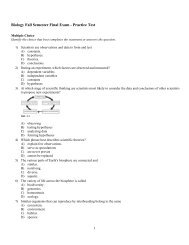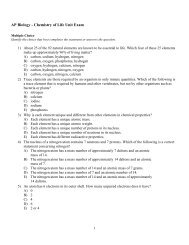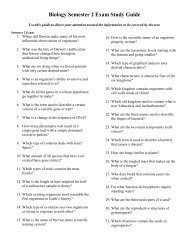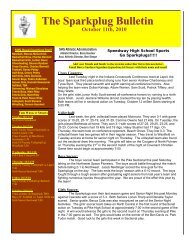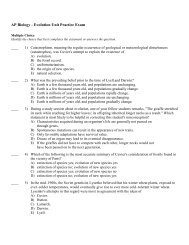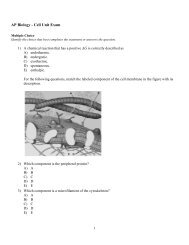ExamView - 2011-2012 AP Ecology Unit Exam.tst - AP Biology
ExamView - 2011-2012 AP Ecology Unit Exam.tst - AP Biology
ExamView - 2011-2012 AP Ecology Unit Exam.tst - AP Biology
You also want an ePaper? Increase the reach of your titles
YUMPU automatically turns print PDFs into web optimized ePapers that Google loves.
46) What is the first step in ecosystem restoration?<br />
A) to restore the physical structure<br />
B) to remove competitive invasive species<br />
C) to restore native species that have been extirpated due to disturbance<br />
D) to identify the limiting factors of the producers<br />
E) to remove toxic pollutants<br />
47) What is the goal of restoration ecology?<br />
A) to speed up the restoration of a degraded ecosystem<br />
B) to prevent further degradation by protecting an area with park status<br />
C) to completely restore a disturbed ecosystem to its former undisturbed state<br />
D) to replace a ruined ecosystem with a more suitable ecosystem for that area<br />
E) to manage competition between species in human –altered ecosystems<br />
48) Which of the following statements is true?<br />
A) An ecosystem's trophic structure determines the rate at which energy cycles<br />
within the system.<br />
B) There has been a well–documented increase in atmospheric nitrogen over the past<br />
several decades.<br />
C) At any point in time, it is impossible for consumers to outnumber producers in an<br />
ecosystem.<br />
D) Chemoautotrophic prokaryotes near deep–sea vents are primary producers.<br />
E) The reservoir of ecosystem phosphorous is the atmosphere.<br />
49) In a typical grassland community, which of the following has the smallest biomass?<br />
A) hawk<br />
B) grass<br />
C) shrew<br />
D) grasshopper<br />
E) snake<br />
50) Nitrifying bacteria participate in the nitrogen cycle mainly by<br />
A) converting ammonium to nitrate, which plants absorb.<br />
B) converting nitrogen gas to ammonia.<br />
C) converting ammonia to nitrogen gas, which returns to the atmosphere.<br />
D) incorporating nitrogen into amino acids and organic compounds.<br />
E) releasing ammonium from organic compounds, thus returning it to the soil.<br />
9



